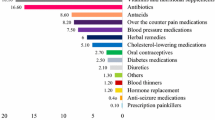Abstract
Objective The objectives of this study were to determine the reasons for returning medications unused and the types of unused medications returned based on therapeutic class. Setting: This study was conducted in a region of New Zealand covered by the Hutt Valley District Health Board. This region has approximately 51,000 households. Methods A ‘Disposal of Unwanted Medication Properly (DUMP)’ campaign was conducted for a four week period in November 2007 in the Hutt Valley DHB region. A collection bag was delivered to every household for the collection and disposal of any unused medications. Participants were instructed to return the bags to a community pharmacy. Those returning medications were also asked to complete a questionnaire to determine why the medications were not used. A sample of the returned medications was identified and quantified and every completed questionnaire was analysed. Main outcome measures: The main outcome measures included: types and quantities of medications returned, calculated costs of these medications and reasons for returns. Results Over the four week period, 1,605 bags were returned for disposal. A total of 329 bags (20%) containing a total of 1,253 items were fully analysed. Only 653 questionnaires were completed (41%) all of which were analysed. The most commonly reported reason for not using the medication was that it had passed the expiry date (26%), the second was treatment change (24%), followed by condition resolved (15%). ‘Alimentary tract & metabolism’ and ‘respiratory systems & allergies’ accounted for 21 and 20% of cost respectively. Conclusions This study found that main reasons identified for patients having unwanted medications were ‘treatment changes’ and ‘expired’. Additionally respiratory medications contributed 20% of the costs associated with unused medications.
Similar content being viewed by others

References
Daughton CG. Cradle-to-cradle stewardship of drugs for minimizing their environmental disposition while promoting human health. II. Drug disposal, waste reduction, and future directions. Environ Health Perspect. 2003;111(5):775–85.
Langley C, Marriott J, Mackridge A, Daniszewski R. An analysis of returned medicines in primary care. Pharm World Sci. 2005;27(4):296–9.
Daniszewsi R, Langley C, Marriott J, Wilson K, Clewes P, Wilkinson M. An investigation of medicines returned to general practitioners and community pharmacies. Int J Pharm Pract. 2002;10(S):R42.
Braybrook S, John D, Leong K. A survey of why medicines are returned to pharmacies. Pharm J. 1999;263(7063):13–5.
Ekedahl AB. Reasons why medicines are returned to Swedish pharmacies unused. Pharm World Sci. 2006;28(6):352–8.
Domino ME, Olinick J, Sleath B, Leinwand S, Byrns PJ, Carey T. Restricting patients’ medication supply to one month: saving or wasting money? Am J Health Syst Pharm. 2004;61(13):1375–9.
Pharmaceutical Management Agency (Pharmac). Annual Review 2007. http://www.pharmac.govt.nz/2007/11/21/PHARMAC_AR_2007.pdf. Last accessed 7 Apr 2009.
Brady K. Pharmaceutical Management Agency: changes to the frequency of medicine dispensing. Office of the Auditor-General; 2005. http://www.oag.govt.nz/2005/pharmac/docs/pharmac.pdf. Accessed 4 Mar 2006.
Braund R, Yuen Y, Jung J. Identification and quantification of medication returned to Otago pharmacies. NZ Fam Physician. 2007;34:258–62.
Braund R, Chuah F, Gilbert R, Gn G, Soh A, Tan L, et al. Identification of the reasons for medication returns. NZ Fam Physician. 2008;35(4):248–52.
Ministry of Health Annual Report - Health and Independence. 2005. http://www.moh.govt.nz/moh.nsf/pagesmh/5315/$File/annual-report0506.pdf. Last accessed 7 Apr 2009.
Mansur N, Weiss A, Beloosesky Y. Is there an association between inappropriate prescription drug use and adherence in discharged elderly patients? Ann Pharmacother. 2009;43:177–84.
Coma A, Modamio P, Lastra CF, Bouvy ML, Marino EL. Returned medicines in community pharmacies of Barcelona, Spain. Pharm World Sci. 2008;30(3):272–7.
Cameron S. Study by Alberta pharmacists indicates drug wastage a “mammoth” problem. CMAJ. 1996;155(11):1596–8.
Paterson JM, Anderson GM. “Trial” prescriptions to reduce drug wastage: results from Canadian programs and a community demonstration project. Am J Manag Care. 2002;8(2):151–8.
Mackridge AJ, Marriott JF. Returned medicines: waste or a wasted opportunity? J Public Health (Oxf). 2007;29(3):258–62.
Ulrik CS, Backer V, Soes-Petersen U, Lange P, Harving H, Plaschke PP. The patient’s perspective: adherence or non-adherence to asthma controller therapy? J Asthma. 2006;43(9):701–4.
Anis AH, Lynd LD, Wang XH, King G, Spinelli JJ, Fitzgerald M, et al. Double trouble: impact of inappropriate use of asthma medication on the use of health care resources. CMAJ. 2001;164(5):625–31.
Molimard M, Le Gros V. Impact of patient-related factors on asthma control. J Asthma. 2008;45(2):109–13.
Mehuys E, Van Bortel L, De Bolle L, Van Tongelen I, Annemans L, Remon JP, et al. Effectiveness of pharmacist intervention for asthma control improvement. Eur Respir J. 2008;31(4):790–9.
Osterberg L, Blaschke T. Adherence to medication. New Engl J Med. 2005;353(5):487–97.
Hugtenburg JG, Blom AT, Kisoensingh SU. Initial phase of chronic medication use; patients’ reasons for discontinuation. Br J Clin Pharmacol. 2006;61(3):352–4.
Braund R, Peake BM, Shieffelbien L. Disposal practices for unused medications in New Zealand. Environ Int. 2009;35:952–5.
Acknowledgements
Hutt Valley DHB and their local pharmacies for their participation.
Funding
New Zealand Pharmacy Education Research Fund for the funding of the summer studentship for GG.
Conflicts of interest statement
The authors have no conflicts of interest to declare.
Author information
Authors and Affiliations
Corresponding author
Rights and permissions
About this article
Cite this article
Braund, R., Gn, G. & Matthews, R. Investigating unused medications in New Zealand. Pharm World Sci 31, 664–669 (2009). https://doi.org/10.1007/s11096-009-9325-9
Received:
Accepted:
Published:
Issue Date:
DOI: https://doi.org/10.1007/s11096-009-9325-9


